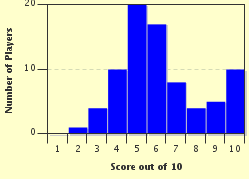Quiz Answer Key and Fun Facts
1. Vultures are large and powerful birds of prey. Which of the following best describes their diet and hunting habits?
2. If you're standing in the middle of the Australian outback and look up to see a flock of large birds circling overhead, are they likely to be wild members of the vulture family?
3. There are many different species of vulture found around the world, but the majority of them share what particular defining characteristic?
4. The Andean condor, a large bird native to western areas of South America with a wing span of well over 2.5 metres (8 feet), is actually a member of the vulture family.
5. New World vultures are known for their habit of defecating on their own legs, which is believed to be a method of keeping themselves cool. What term is given to this distinctly unpleasant technique?
6. The lammergeier, Gypaetus barbatus, can be easily identified from other circling vultures as it has particularly long, narrow wings and a long wedge shaped tail. By what alternative name is it commonly known?
7. In areas of South Asia you are now much less likely to see vultures circling in the sky due to a dramatic population crash that occurred in the 1990s and 2000s. This loss has been linked to vultures eating animal carcasses containing traces of what drug that is often used to treat pain and inflammation in humans?
8. Sarcoramphus papa is a New World vulture that has a particularly distinctive multi-coloured appearance. Its image appears regularly in the codices of the ancient Maya civilisation, but by what regal sounding common name is it now known?
9. Which of these interesting habits do vultures sometimes employ when they need to make a quick airborne getaway?
10. Which of these kitchen implements is also a collective noun for vultures in flight?
Source: Author
Fifiona81
This quiz was reviewed by FunTrivia editor
Tizzabelle before going online.
Any errors found in FunTrivia content are routinely corrected through our feedback system.

